This article was medically reviewed by Cara Piskai. Dr. Cara Piskai, DMD is an Orthodontist and the Owner of Piskai Orthodontics in Voorhees, New Jersey. She has over five years of experience in orthodontics and dentofacial orthopedics. She completed a Doctor of Dental Medicine degree at the University of Pennsylvania School of Dental Medicine. She completed her residency and earned a Specialty Certificate in Orthodontics and a Master's degree in Oral Sciences at the University of Illinois-Chicago. Dr. Piskai is board-certified by the American Board of Orthodontics and is a member of the American Association of Orthodontists (AAO). She holds a position on the U.S. News & World Report Medical Review Board.
There are 20 references cited in this article, which can be found at the bottom of the page.
wikiHow marks an article as reader-approved once it receives enough positive feedback. In this case, several readers have written to tell us that this article was helpful to them, earning it our reader-approved status.
This article has been viewed 216,525 times.
Many people have braces to help correct and straighten their teeth. But keeping your teeth clean with braces may present a challenge for you. By carefully choosing a toothbrush and making sure to thoroughly brush around and between your braces, you can have clean and gleaming teeth—and braces!
Steps
Brushing Your Teeth and Braces
-
1Get a special toothbrush for braces. Since braces require placing devices on your teeth, use a proper toothbrush or toothbrushes. Purchase a regular brush and consider adding a braces-specific proxabrush to get between brackets.[1]
- Get a regular brush with soft bristles.[2]
- Make sure the brush size and shape fit your mouth, which can help reach all areas of your mouth.[3]
- Buy a proxabrush, or “Christmas tree” brush, if you like. This may help you more effectively clean between braces.[4]
- Replace any brush with frayed bristles or every 3-4 months.[5]
-
2Prepare your brush. Run your toothbrush(es) under water and put a pea-sized dollop of toothpaste on it.[6] This can ensure the most effective cleaning of your teeth, braces, and oral cavity.Advertisement
-
3Tackle brushing in four sections. Section your mouth into top, left, right, and bottom quadrants for brushing. Setting up specific sections can help you make sure that every surface is properly cleaned.
- Brush whichever section you want or what makes you most comfortable.
- Make sure to brush your tongue and the roof of your mouth as well.
- Hold your toothbrush at a 45-degree angle using gentle pressure.[9] [10] Make sure the brush stays in contact with the surface of your teeth and gum line.[11]
- Make sure to brush all the surfaces of your teeth and the part of your gums that sit right above the teeth. The 45-degree angle is important to help you clean the surfaces above the brackets on the upper teeth and below the brackets on the lower teeth, since this is where plaque often accumulates.[12]
- Brush from outer to inner tooth surfaces with short strokes and repeat the process for each section of your mouth.[13]
- Brush the inside surfaces of your front teeth by angling the brush vertically and making several up and down strokes.[14]
- Pay attention to the surfaces around and in-between your braces, which is where plaque can build up.[15]
- Brush chewing surfaces, your tongue, and soft palate using a scrubbing motion that gently goes back and forth.[16]
- Wearing braces means that your gums will always be slightly inflamed, so expect small amounts of bleeding. This is normal.
-
4Use your proxabrush. When you’ve finished using your regular brush, consider using a proxabrush, or “Christmas tree” brush. This may help you more effectively clean between individual brackets if you are concerned your regular brush isn’t enough.[17]
-
5Floss your teeth.[20] Each time you brush your teeth, take time to floss as well. Because debris can easily get stuck in teeth with braces and plaque can build up, flossing is can help remove lingering debris.[21]
- Remove about 18 inches of floss from the packaging. Wrap it around your middle fingers.[22] Grasp the rest between your thumbs and forefingers.[23]
- Gently feed the floss between the top of your tooth near the gum and the main arch wire of your bracket.[24]
- Use a gentle sawing motion on the side of each tooth.[25]
- Ask your orthodontist if there is a specific type of floss you should use.
- The floss used to clean dental bridges may be a good option because it has a tip that gently goes between your teeth and gums.
- Try water-flossing if you don’t like regular floss or your doctor suggests it.
-
6Use an antiseptic mouth rinse. Rinse your mouth with mouthwash after you’ve brushed and flossed. Studies have shown that using a mouthwash may decrease plaque, which can be a problem for people with braces. It may also clear lingering food particles or bacteria.[26]
- Swish the mouthwash in your mouth.
- Buy a mouthwash with chlorhexidine, which many oral care professionals recommend. Mouthwashes containing alcohol can dry out your mouth and cause bad breath.[27]
-
7Take a pain reliever. You may have some tenderness if you recently had your braces tightened or adjusted.[28] Don’t let this deter you from brushing. Take an over-the-counter pain medication to relieve discomfort.
- Take over-the-counter pain relievers such as aspirin, ibuprofen, naproxen sodium, or acetaminophen.[29]
- Let your orthodontist know if you are in a lot of pain.[30] It is better to return to your orthodontist for another 5 minutes to get a small adjustment than to suffer from increased pressure, which may produce long term negative effects.
Maintaining Oral Health with Braces
-
1Brush and floss daily. Brush and floss your teeth and braces daily as well as after meals. This can minimize plaque and remove debris and bacteria.[31]
- Make sure to brush your teeth at least three times a day and after every meal. Ideally, you would brush once in the morning, once after lunch or as soon as you get home from school or work, and once before bed. [32]
-
2Maintain a healthy diet. Watching what you eat can promote overall and oral health. Eat a balanced diet that is low in sugary foods to minimize plaque or stain formation around your braces.[33]
- Eat lean proteins, fruits and vegetables, and legumes.
- If you eat something sugary, consider brushing your teeth when you’re done.
- Some examples of sugary foods and drinks to stay away from are soft drinks, sweets, candies, and even wine.
-
3
-
4Avoid grinding your teeth. If you clench or grind your teeth, you could damage your teeth or braces. Ask your dentist or orthodontist about using a mouth guard.
- Grinding wears can cause sensitivity and damage such small chips and cracks in your teeth.
- Avoid biting your nails, opening bottles, or holding things in your mouth.
-
5See your dentist and orthodontist regularly. Regular checkups and cleanings with your dentist are important to maintaining oral health. You should also visit your orthodontist regularly to help correct your teeth. Visit your dentist at least twice a year and your orthodontist as often as she suggests.
- Consider using a dentist and orthodontist who work together.
Expert Q&A
-
QuestionWhat is the easiest way to floss with braces?
 Cara PiskaiDr. Cara Piskai, DMD is an Orthodontist and the Owner of Piskai Orthodontics in Voorhees, New Jersey. She has over five years of experience in orthodontics and dentofacial orthopedics. She completed a Doctor of Dental Medicine degree at the University of Pennsylvania School of Dental Medicine. She completed her residency and earned a Specialty Certificate in Orthodontics and a Master's degree in Oral Sciences at the University of Illinois-Chicago. Dr. Piskai is board-certified by the American Board of Orthodontics and is a member of the American Association of Orthodontists (AAO). She holds a position on the U.S. News & World Report Medical Review Board.
Cara PiskaiDr. Cara Piskai, DMD is an Orthodontist and the Owner of Piskai Orthodontics in Voorhees, New Jersey. She has over five years of experience in orthodontics and dentofacial orthopedics. She completed a Doctor of Dental Medicine degree at the University of Pennsylvania School of Dental Medicine. She completed her residency and earned a Specialty Certificate in Orthodontics and a Master's degree in Oral Sciences at the University of Illinois-Chicago. Dr. Piskai is board-certified by the American Board of Orthodontics and is a member of the American Association of Orthodontists (AAO). She holds a position on the U.S. News & World Report Medical Review Board.
Orthodontist Use a floss threader, which allows you to thread the floss underneath the wire and get between the teeth. You can also use Super Floss—this is individual strands of floss that have a stiffer end that serve as a threader, connected to a spongy floss segment and a regular floss segment.
Use a floss threader, which allows you to thread the floss underneath the wire and get between the teeth. You can also use Super Floss—this is individual strands of floss that have a stiffer end that serve as a threader, connected to a spongy floss segment and a regular floss segment. -
QuestionHow am I expected to floss when I can't even brush without pain?
 Cristian Macau, DDSDr. Macau is an oral surgeon, periodontist, and aesthetician at Favero Dental Clinic in London. He received his DDS from Carol Davila University of Medicine in 2015.
Cristian Macau, DDSDr. Macau is an oral surgeon, periodontist, and aesthetician at Favero Dental Clinic in London. He received his DDS from Carol Davila University of Medicine in 2015.
Doctor of Dental Surgery Visit your orthodontist if you have pain when brushing. Increased pain is not normal, and you should definitely have a specialized consultation. Flossing is different from brushing and should not cause any pressure on your teeth if you do it properly. Good hygiene is the key to a successful orthodontic treatment.
Visit your orthodontist if you have pain when brushing. Increased pain is not normal, and you should definitely have a specialized consultation. Flossing is different from brushing and should not cause any pressure on your teeth if you do it properly. Good hygiene is the key to a successful orthodontic treatment. -
QuestionWill there be a needle in this process?
 Cristian Macau, DDSDr. Macau is an oral surgeon, periodontist, and aesthetician at Favero Dental Clinic in London. He received his DDS from Carol Davila University of Medicine in 2015.
Cristian Macau, DDSDr. Macau is an oral surgeon, periodontist, and aesthetician at Favero Dental Clinic in London. He received his DDS from Carol Davila University of Medicine in 2015.
Doctor of Dental Surgery No. Needles are not required when starting an orthodontic treatment. Braces brackets are simply stuck to your natural teeth, and a wire is passed through from one end to the other, allowing teeth to be arranged in a natural and functional position which leads to a perfect bite.
No. Needles are not required when starting an orthodontic treatment. Braces brackets are simply stuck to your natural teeth, and a wire is passed through from one end to the other, allowing teeth to be arranged in a natural and functional position which leads to a perfect bite.
Warnings
- If something in your braces looks wrong, contact your orthodontist.⧼thumbs_response⧽
- If you experience pain or bleeding because of your braces, contact an orthodontist.⧼thumbs_response⧽
Things You'll Need
- Toothbrush
- Toothpaste
- Floss/Water-flosser
- Proxabrush (Christmas tree brush)
- Mouthwash
Expert Interview
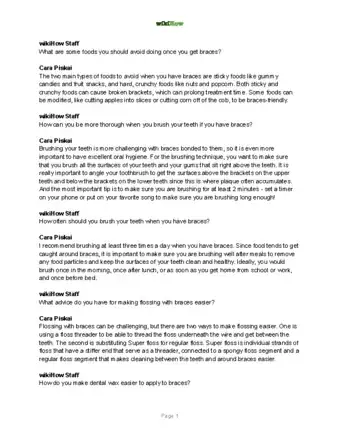
Thanks for reading our article! If you'd like to learn more about wearing braces, check out our in-depth interview with Cara Piskai.
References
- ↑ https://simplyorthodontics.ca/blog/do-i-need-special-toothbrush-toothpaste-braces
- ↑ https://www.colgate.com/en-in/oral-health/selecting-dental-products/is-there-a-special-toothbrush-for-braces-
- ↑ http://www.mouthhealthy.org/en/az-topics/b/brushing-your-teeth
- ↑ http://www.webmd.com/oral-health/guide/care-of-braces-retainers
- ↑ http://www.ada.org/en/science-research/ada-seal-of-acceptance/product-category-information/toothbrushes
- ↑ http://www.ada.org/1322.aspx
- ↑ https://simplyorthodontics.ca/blog/do-i-need-special-toothbrush-toothpaste-braces
- ↑ https://www.tisserontorthodontics.com/blog-post/toothpaste-for-braces
- ↑ https://www.putnamorthodontics.com/brushing-and-flossing-with-braces/
- ↑ Cara Piskai. Orthodontist. Expert Interview. 20 December 2022.
- ↑ http://www.adha.org/sites/default/files/7221_Proper_Brushing_1.pdf
- ↑ Cara Piskai. Orthodontist. Expert Interview. 20 December 2022.
- ↑ https://www.putnamorthodontics.com/brushing-and-flossing-with-braces/
- ↑ https://www.putnamorthodontics.com/brushing-and-flossing-with-braces/
- ↑ https://boerneorthopedo.com/orthodontics/brushing-and-flossing-with-braces/
- ↑ http://www.adha.org/sites/default/files/7221_Proper_Brushing_1.pdf
- ↑ http://www.webmd.com/oral-health/guide/care-of-braces-retainers
- ↑ http://www.webmd.com/oral-health/guide/care-of-braces-retainers
- ↑ http://www.webmd.com/oral-health/guide/care-of-braces-retainers
- ↑ Cara Piskai. Orthodontist. Expert Interview. 20 December 2022.
- ↑ https://boerneorthopedo.com/orthodontics/brushing-and-flossing-with-braces/
- ↑ https://www.donaldsnyderdds.com/brushing-and-flossing-with-braces
- ↑ https://www.donaldsnyderdds.com/brushing-and-flossing-with-braces
- ↑ http://www.webmd.com/oral-health/guide/care-of-braces-retainers
- ↑ http://www.webmd.com/oral-health/guide/care-of-braces-retainers
- ↑ http://www.ncbi.nlm.nih.gov/pubmed/23579302
- ↑ http://www.ncbi.nlm.nih.gov/pubmed/23579302
- ↑ https://www.overbyorthodontics.com/braces-pain-relief-tips/
- ↑ Cara Piskai. Orthodontist. Expert Interview. 20 December 2022.
- ↑ https://braceshaven.com/braces-pain/
- ↑ Alina Lane, DDS. Board Certified Dentist. Expert Interview. 21 April 2020.
- ↑ Cara Piskai. Orthodontist. Expert Interview. 20 December 2022.
- ↑ http://www.mouthhealthy.org/en/az-topics/b/braces
- ↑ http://www.mouthhealthy.org/en/az-topics/b/braces
- ↑ Cara Piskai. Orthodontist. Expert Interview. 20 December 2022.
- ↑ Cara Piskai. Orthodontist. Expert Interview. 20 December 2022.
- ↑ Cara Piskai. Orthodontist. Expert Interview. 20 December 2022.
- ↑ http://www.mouthhealthy.org/en/az-topics/b/braces
- ↑ Cara Piskai. Orthodontist. Expert Interview. 20 December 2022.
About This Article
To clean your teeth if you have braces, try using a normal brush with soft bristles to brush your teeth. You can also make sure the spaces between the brackets stay clean by using a proxabrush. Insert the brush through the top of the bracket and clean 2 teeth at a time. In order to clean your teeth, place a pea-sized amount of toothpaste onto your brush to ensure your teeth and braces are cleaned. For even better results, use a fluoride toothpaste, which can help remove plaque that may build up around your braces. As you brush, divide your mouth into four sections, top, right, left, and bottom, to make sure you’re cleaning all of your teeth properly. To learn more from our Dental co-author, including how to floss your teeth if have braces, read on!
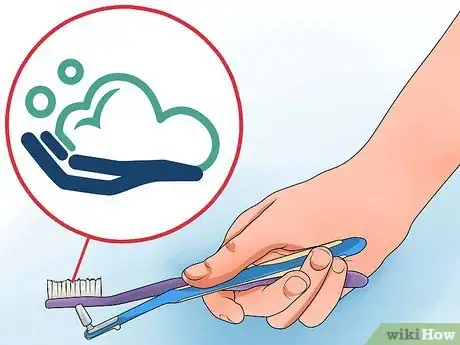
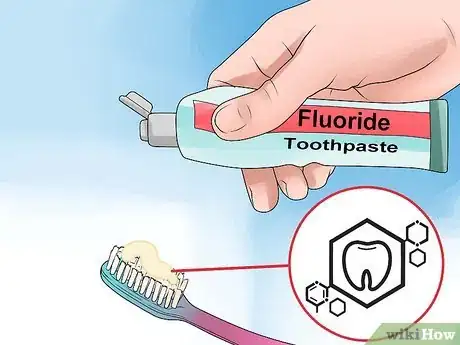
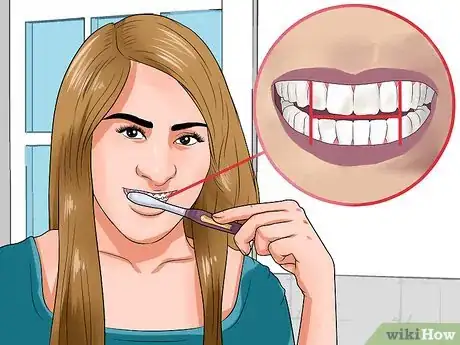

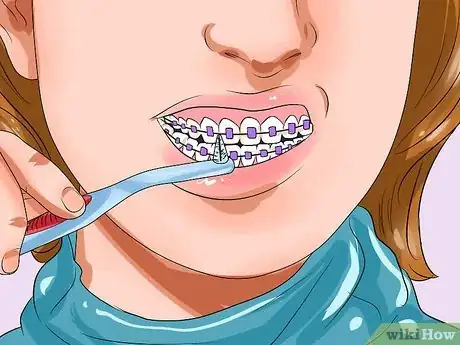

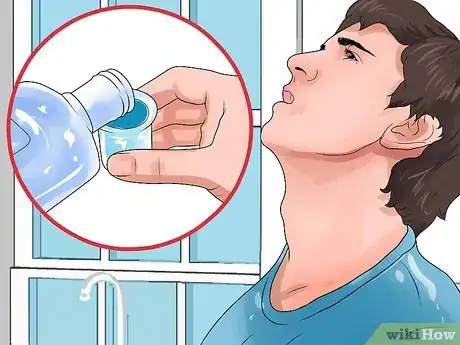
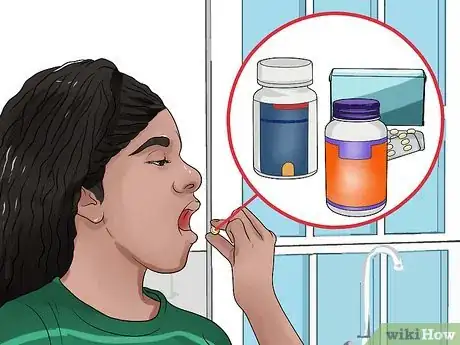
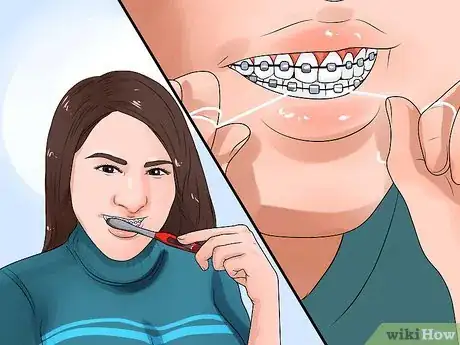

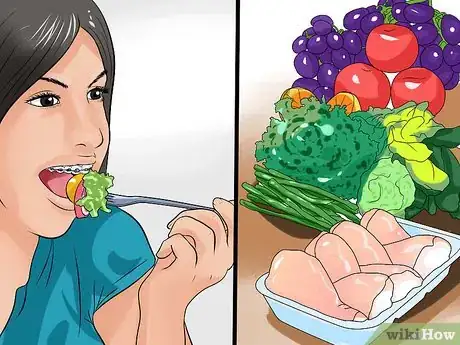
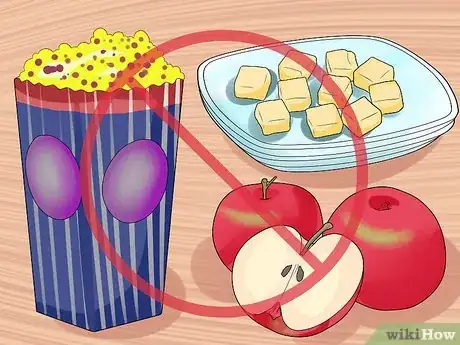
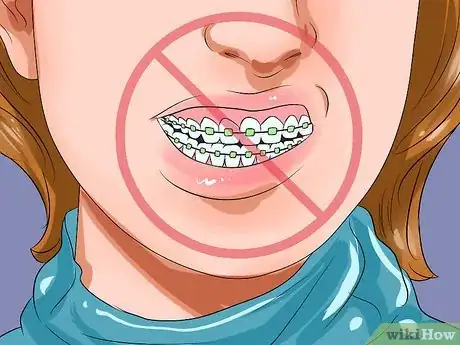
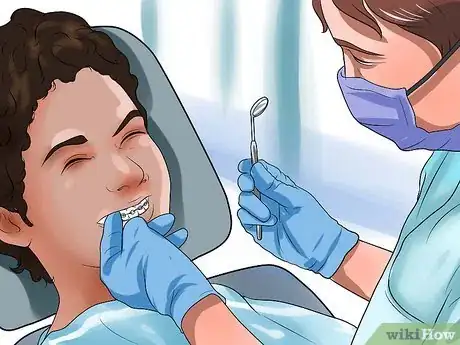

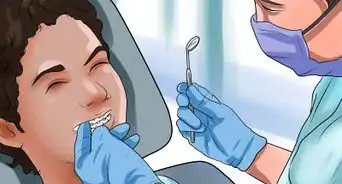
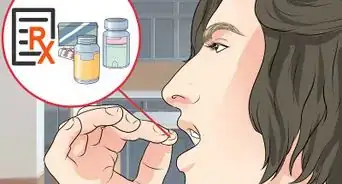

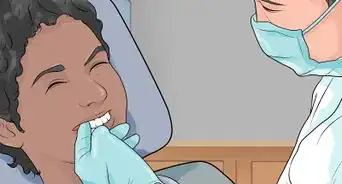
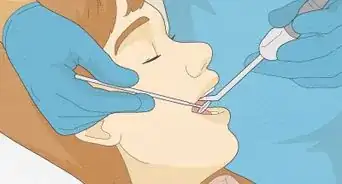




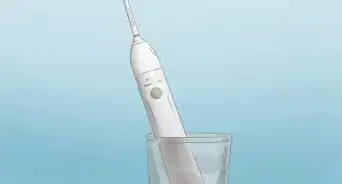

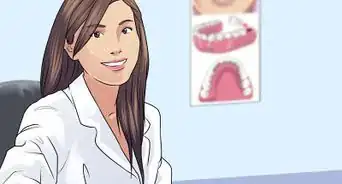









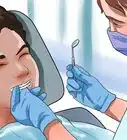

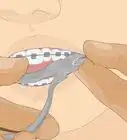



































Medical Disclaimer
The content of this article is not intended to be a substitute for professional medical advice, examination, diagnosis, or treatment. You should always contact your doctor or other qualified healthcare professional before starting, changing, or stopping any kind of health treatment.
Read More...